Strategy July 21, 2014
Can This Shop Be Saved?
Point Embroidery & Screen in central Wisconsin operated at a loss last year, with nice-guy owner Craig Wold too worried about losing business to raise prices – or even to insist on payment in full. The shop itself was a hoarder’s paradise, and getting organized seemed a Sisyphean struggle. Stitches sent The Embroidery Coach, Joyce Jagger, to whip Wold’s business into shape.
Stevens Point, WI, in late March is cold and nearly colorless – just the flat, grayish tinge of lingering winter. Tucked behind a line of snow-dusted shrubs and spindly trees, the squat building that houses Point Embroidery & Screen blends into the landscape, as if wearing a layer of camouflage. Inside, however, it’s a riot of clashing color: a neon-yellow jacket with reflective stripes is wedged between dark tops; stacks of folded shirts – bright green and orange and pink – skim the ceiling, abutting piles of plastic-wrapped caps; cone after cone of thread create a rayon rainbow against the far wall; papers and folders litter a long computer desk.
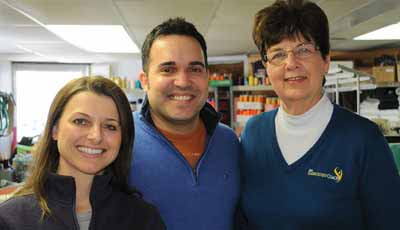
The mess spills into production, with owner Craig Wold and his three employees struggling to bring order to the chaos. “A lot of times a job will come in, and we can’t find the product. Sometimes, we can’t even find the invoice,” Wold says. “It’s stuff that slows you down. It’s frustrating.”
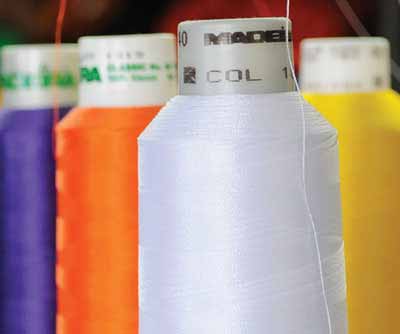
Eager to escape cubicle life and tap into his creative side, Wold bought the decorating business three years ago from a friend. At the time, he didn’t even know how to turn on an embroidery machine. He learned the ropes from the previous owner, but also picked up some bad habits along the way – not to mention inheriting a basement bursting with decades’ worth of obsolete artwork, screens and just plain junk. “A lot of the old stuff, I don’t even know what it is,” Wold says. “We’ll literally just kick boxes down there.”
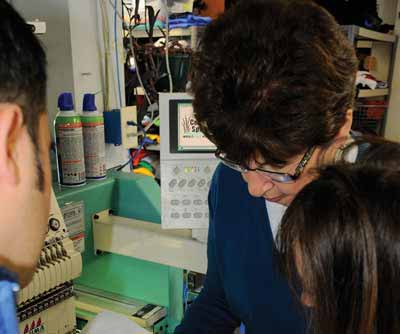
An amiable man in his early 40s with a stocky build, styled hair and a ready smile, Wold always has a minute – or 20 – to spare for the people who stop by his shop. Quick to point out that he’s not a “complete pushover,” Wold admits, when pressed, that many customers still owe him a pretty penny for completed work. The shop doesn’t require a down payment before accepting orders, doesn’t insist on payment at pickup and has no system for collecting outstanding debts. Wold doesn’t have a business plan, a marketing strategy or a documented production process. His employees have complained that his tendency to keep “everything in his head” leads to confusion and delays. Though Point Embroidery does steady business, posting $213,000 in sales last year, the shop was operating at a loss of more than $10,000, and Wold hasn’t given himself a salary since he bought the business.
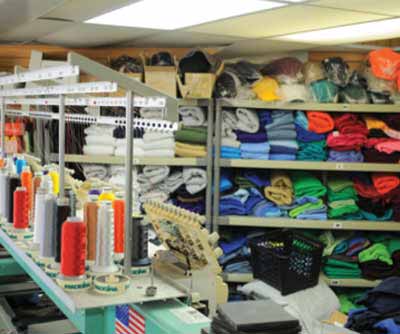
Something needed to change.
Enter Joyce Jagger, a 6-foot-tall column of calm and efficiency, clipboard in one hand, protein shake in the other. Stitches sent the 75-year-old industry veteran and renowned trainer known as The Embroidery Coach to Wisconsin for two whirlwind days to lend her expertise and determine whether Point Embroidery & Screen can be saved. Jagger’s initial assessment: “Two days isn’t enough. I’d like to come in and stay a month.”

Spring Cleaning
On the morning of her arrival, Wold takes Jagger on a tour of the business, guiding her across a faded navy and gray carpet bearing stylized M’s, a relic of the building’s previous life as a Maytag repair shop. Jagger immediately zeroes in on the thousands of dollars in blank inventory stuffed into what could be an attractive showroom.
“You really have no reason to have this much inventory,” she says, explaining that all Wold needs are a few samples and some examples of his work on display. Everything else can be shipped in two days or less.

On to the production area: Two embroidery machines, a six-head and a four-head, are set up in a line, but face opposite directions, unable to be overseen efficiently by the same operator. Green plastic hoops of varying sizes hang haphazardly from nearly every wall. A computer sits a few feet away from the embroidery machines. Propped nearby is a dry-erase board crowded with cryptic messages in red and purple marker – phrases like “BUGS BUNNY CERAL” and “Drunk fisherman – design final version.” Some words are circled or have stars sketched beside them. Organized into columns for printing, artwork and embroidery, the whiteboard is Wold’s attempt to keep track of his orders, though employees admit to confusion over some of the hastily scrawled, smudged notations.
Jagger looks around, snapping photos with her smartphone. She asks Wold if his team steams a garment before it goes out the door. They don’t. And how do they remove the topping after a garment is embroidered? Wold says they spray it with water to dissolve the stabilizing solution. “Sometimes, we’ll have stuff laid out all over everything to dry,” he says.
The Embroidery Coach shakes her head sharply. “That’s very unprofessional,” she says, and recommends wetting a wad of excess topping and dabbing it like a ball of glue to pick up what remains on the garment. “You need to have someone who just does finishing: taking out the backing, cutting threads, steaming, packing,” she says.
Wold discloses later that he used to have an older woman on staff to help with finishing, but it didn’t work out. “She couldn’t trim, but she needed the money, so I wanted to help her out,” he says.
Another corner of the shop is filled with unused equipment: a single-head embroidery machine with missing software and an old copier. Behind the bulky machines is a small office that houses the shop’s computer servers. “What do you do with this area?” Jagger asks, pointing to the enclosed nook.
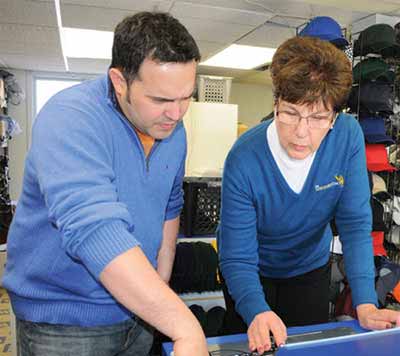
“Mostly, it’s just a dump,” Wold says. However, Jagger envisions it as the accounting office, a place to meet privately with customers, or even just a space for Wold to get some management work done without distractions.
“You need a place where you can get away,” Jagger says. “Don’t you ever feel like you want to get away?”
Wold sighs, “All the time.”
“I said get away, not run away,” Jagger says.
After a quick stop in the screen-printing room, it’s time to descend into the shadowy basement, which Wold describes as his “biggest nightmare.” A dumpster he and the staff filled up last summer barely made a dent in the accumulated clutter. Wold and Jagger head over to a cluster of waist-high cardboard boxes overflowing with old unfiled artwork.
“Lots of people will say, ‘You did my logo 10 years ago; do you still have it?’ ” Wold says. “Believe it or not, we still do.”
Jagger isn’t impressed, wanting to know how often he actually pulls from the old artwork. The answer? Hardly ever.
“Throw it all out. Literally,” she says. “It costs you money to store it.”
Once the basement is purged, she says, Wold can catalog his inventory, stowing the blanks in sealed tubs downstairs, thus freeing up space for a needed showroom and a more streamlined, efficient workflow upstairs. To ramp up production, she recommends flipping one of the embroidery machines, setting aside a spot for hooping and finishing, and an area to process deliveries. She also recommends hiring a part-time bookkeeper, designating one employee to handle hooping and another to do finishing so that the embroidery machine operator can better focus on output. “If you had separate hooping, you could keep those machines singing,” Jagger says. “They need to run 45 minutes of every hour.”
The Price Isn’t Right
Later in the day, Jagger and Wold settle down in front of his computer to go over pricing. Wold tells Jagger that he doesn’t have a standard price list for embroidery, with different customers receiving different prices – quotes that he sometimes forgets since the shop’s record-keeping is inconsistent at best.
“We have to create a price sheet,” Jagger says. The statement draws immediate and effusive gratitude from Michelle Swatek, one of Wold’s employees: “Thank you. God bless you,” she gushes, leaning over to give Jagger a quick hug. Swatek is a no-nonsense woman with a knack for baked goods and a tendency to bring up anecdotes from her previous gig at a much larger embroidery outfit – “They probably get tired of hearing me say, ‘This is how we did it at Land’s End,’ ” she says with a laugh.
Jagger calls up her subscription-based website, The Embroidery Training Resource Center, her manicured fingers poised to crunch some numbers. “How much does it cost you to run per hour?” she asks Wold.
“I have no idea,” he says.
This gives her pause. “You should know that down to the second,” she says. “It’ll be a real eye-opener.”
Jagger grabs a nearby sew-out of one of the shop’s designs: a simple green and white logo, consisting of about 6,500 stitches. It’s for PSOL, the local IT security firm that installed Wold’s backup servers. She asks how much he’d charge for the design.
“That one’s a $5.95er,” Wold says. “It probably takes me about 10 to 15 minutes to finish.”
Wold says he’ll sometimes knock off 50 cents for larger orders or for frequent customers. He hasn’t been charging for setup or cleanup of the artwork, nor does he charge enough for digitizing. Sometimes, he says, he’ll try to come up with the true cost of his work, estimating in his head the stitch count and how much time an order will take, what that will mean for the bottom line. “But then I don’t really change my price,” he says. “Nothing really happens. I just chalk it up to a break-even, or sometimes a loss.”
“You need to be making something on every job,” Jagger admonishes. “I can almost guarantee you’re losing more money than you think you are on every job.” She glances down at the PSOL logo again. “I’d charge a lot more than $5.95.”
A week after her visit, Jagger e-mails Wold a detailed spreadsheet, pricing his embroidery based on stitch count and shop expenses. For a 6,000-stitch embroidery design, Wold should be charging about $8.61 each on an order of six, to ensure a 40% profit margin, according to Jagger’s calculations.
While still in Wisconsin, however, Jagger takes Wold and his staff on a virtual tour of her website, showing off some of the other forms available to her paying clients: customer design approval forms, an embroidery production worksheet and much more. She recommends keeping paperwork simple, but complete, creating a folder for each order that contains copies of the design, invoice, packing slips and anything else relevant. With everything clearly organized, handling reorders (not to mention getting the original order out) is a breeze, she says.
Midway through the conversation, a customer comes in, and Wold jumps up to greet him. They discuss his order for a few minutes, and then move onto small talk. When Wold saunters back to Joyce some 15 minutes later, she says: “That probably cost you at least $20.”
Logo a No Go
Before flying out to Wisconsin, Jagger did some rudimentary online digging of Point Embroidery & Screen. The shop has no presence on social media, and its website is little more than a placeholder. It wasn’t until she arrived in the shop, however, that she discovered how little effort Wold had put into marketing. Jagger is in the midst of explaining how she’ll give away a sample shirt once the supplier no longer offers that style: “It’s got my logo embroidered on it.”
“Yeah, I don’t even think I have my logo digitized,” Wold muses.
Jagger stares at him, momentarily shocked, and then utters a phrase, repeated so often during her short visit to the heart of the Badger State that it’s like a mantra: “You have got to be kidding.”
“No,” Wold says.
“You should have a logo on everything you wear out of here,” she says, tapping the discreet gold and white letters spelling out “The Embroidery Coach” on the left chest of her black V-neck sweater.
“I don’t have the time to put my logo on,” Wold begins, before registering Jagger’s stern expression. “I need to make time.”
“It’s a cheap, cheap way of marketing,” Jagger says, turning to Wold’s employees who lean against the front counter, watching the exchange. “Get his logo done. Pick out some clothes that you think he’s going to wear and get his logo on them.”
The interchange illustrates one of Wold’s key issues, in Jagger’s estimation. He doesn’t understand his role as shop owner, preferring to be in the thick of every job, no matter how mundane. Because he can’t delegate or set priorities, he hasn’t had time to create a business plan or get organized. He doesn’t seek out chamber of commerce meetings or other networking events to entice potential new customers. “You need to direct the whole business,” Jagger says. “You, as the owner, need to focus on the numbers and selling.”
Staying Sharp
On her second day at Point Embroidery & Screen, Jagger focuses on the quality of the shop’s embroidery. She shows Wold and Swatek how to use a pin oiler every four hours to keep the machines running smoothly: “All you need is a drop.” Every six months, the embroidery machines need to be “thoroughly, totally cleaned,” using a cotton swab dipped in rubbing alcohol, she says.
Jagger explains that ballpoint needles should be used for knits because they split the fibers rather than making a hole; sharp needles are better for piercing woven fabrics. Jagger recommends switching to 75/11-size needles, rather than 70/10s, a trick she says she discovered by accident years ago. “Just changing your needle will give you a sharper, finer detail.”
After examining a box full of the shop’s old sew-outs, Jagger determines that the team’s thread tensions have been running too loose. Many designs have no bobbin showing, leaving the thread loopy and in danger of being pulled out, she says. Jagger whips out a small plastic wand with a hook on the end, and shows them how to use the tension gauge to fix the problem. “This is kind of cool,” Wold says. “I never even knew something like this existed.”
Jagger also tells them to stop using polyester and rayon thread interchangeably, noting that rayon bleaches out over time, and that they require different tensions to run properly. Stick to polyester, and store it in covered plastic tubs to protect it from dirt and rot, she advises. “If you’re getting thread breaks, it’s costing you money,” she says.
She demonstrates the use of her hooping grade, a plastic template that helps standardize logo placement on a garment. Jagger had learned the day before that Wold does his hooping freehand, “by eye and feel,” a statement that elicited a slow head shake and a muttered, “Oh, jeez,” from Jagger. Using the hooping grade and fabric-marking pens, she says, “is much more precise than just eyeballing.”
What’s the Verdict?
As Jagger’s visit draws to a close, Wold is exhausted and more than a little daunted by the tasks that lie ahead. “Do you see potential?” he asks uncertainly. Without missing a beat, Jagger answers: “Oh, absolutely.”
It’s not the technical, organizational or financial flaws Jagger enumerated in detail over the last two days that inhibit Point Embroidery & Screen’s success. Though they’re contributing factors, the crux of the matter is Wold’s attitude – toward his work, his time and his staff. “Your time is extremely valuable; you’re not valuing it at all,” Jagger says. “You’ve got to change your total mindset. People will pay, especially for quality work and quick turnout.”
Wold nods. “I want to take the business to the next level,” he says. “I know it’s not going to be overnight.”
If Wold follows Jagger’s advice, annual sales could easily shoot from $200,000 to $800,000, Jagger says. “I want to see sales go up here,” she adds, flinging her arm to the aging drop ceiling. “There’s no reason they can’t. It would be nice if one of those checks that you’re writing goes to Craig Wold. That’s a nice reward.”
What Happened Next
Joyce Jagger’s two-day visit to Wisconsin was only the beginning of her involvement with Point Embroidery & Screen. The Embroidery Coach says she has been treating owner Craig Wold like one of her $5,000 clients, following up weekly to ensure he’s changing his ways. Here are some highlights of Wold’s progress:
Week One
Wold and his employees filled up a dumpster with old artwork and other junk from the basement. Wold believes he can fill at least two more over the next few months.
He implemented a logging-in system, a first step toward keeping track of his jobs and smart paperwork flow.
Week Two
The shop started requiring a 50% down payment on orders.
Wold raised prices midway between what he’d previously been charging and the pricing structure Jagger created. Wold says he’s been pleasantly surprised that the increases haven’t caused customers to balk.
Week Three
Wold attended a meeting for a business networking group and has started the process of becoming a member.
He moved into the back office, but struggles with giving up control of production.
Week Four
With the help of his employees, Wold set up a Facebook page for Point Embroidery & Screen (Facebook.com/pointembroidery and screen).
The staff also rearranged the production area, with an area set up for package delivery and another for finishing garments.
Week Five
Wold purchased an additional computer meant for digitizing only. Prior to that, employees had been using the same machine for embroidery and screen-printing artwork, often delaying production.
Week Six
Point Embroidery & Screen has more than 160 likes on its Facebook page, with Wold posting photos of completed jobs.
Week Seven
Now, stickers asking customers to “like” Point Embroidery on Facebook are slapped onto every box sent out of the shop.
The shop did a record $12,000 in sales as it wound down a busy two-week period.
Week Eight
Michelle Swatek, the shop’s embroidery operator, quit without notice, leaving a big job undone. Wold’s other two employees are also moving on, though his screen printer found him a replacement. Jagger advised Wold to put an ad on Craig’s List to find a new embroidery machine operator.
Wold and his wife continue to organize the shop, moving inventory into the basement.
Final Thoughts
A few months after her trip to Wisconsin, Jagger is pleased with the changes Wold has made: cleaning out his basement, raising prices, requiring down payments, signing up for her training website and exploring networking opportunities. “He’s made a ton of progress,” she says. “He’s bringing in money faster and [in larger amounts] than he did before.”
But, Jagger adds, Wold still has a way to go until his shop reaches its full potential. Though his prices are higher than they were in March, they’re not at the level Jagger recommended. His de-cluttered showroom is showing sample apparel to better effect, but Wold still isn’t displaying examples of his embroidery and screen printing to wow customers.
Jagger says she’ll continue working with Wold over the next few months, holding his hand as he baby-steps toward success. “I’m not going to let this drop,” she says. “I want to see him go much farther than this.”
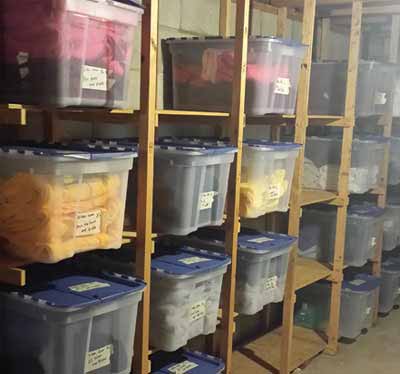
1. Craig Wold filled five dumpsters with the two decades of old artwork and paperwork that had accumulated in the basement of Point Embroidery & Screen. The shelves now hold plastic tubs full of excess T-shirts and other inventory.
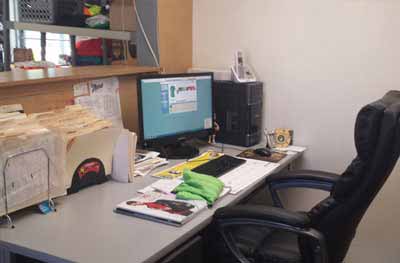
2. Wold cleaned out the office area, removing unused wire shelving, old computer equipment and the noisy computer server. Now, the desk is set up so Wold can update his paperwork without clogging up the production area.
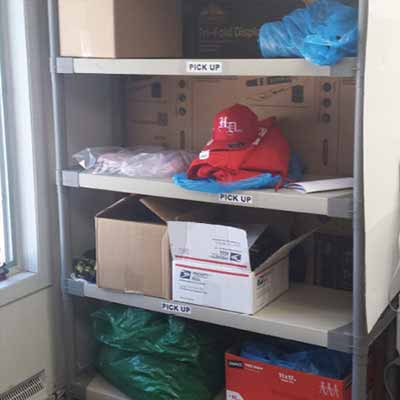
3. Now that Point Embroidery has a designated pickup area, employees don’t have to waste time hunting for a customer’s order, Wold says.
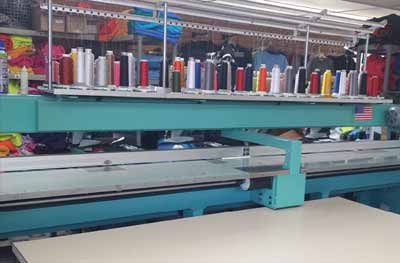
4. Wold removed unused equipment and cleared off a table, which is now used exclusively for hooping garments. Another area in the shop is set aside for finishing them. Other updates to the production area include designated graphic and embroidery design stations with upgraded computers.
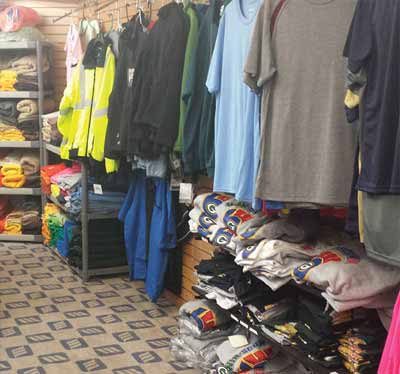
5. Wold cleared out a lot of the inventory in his showroom and is working to display samples to their best advantage. “For me, it was really hard to change things, visually and policy-wise,” Wold says. “I know I’m a work in progress. … I have to keep reminding myself: baby steps, baby steps.”
